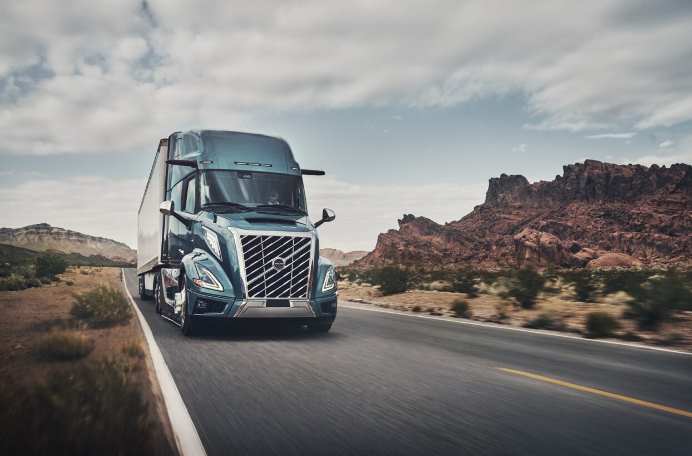GREENSBORO, N.C. — During a virtual press conference Jan. 23, Volvo Trucks North America announced the launch of a completely reimagined Volvo VNL. The OEM promises the new version will set new industry standards in heavy-duty trucking.
“The all-new Volvo VNL was designed to change everything,” said Peter Voorhoeve, president of Volvo Trucks North America, adding that “change” goes beyond a redesigned truck. “This product introduction is the start of a new era for Volvo Trucks, our customers and their drivers — a quantum leap forward.”
According to the manufacturer, the new Volvo VNL is equipped with the next generation of enhancements to improve total customer value, driver productivity, safety and sustainability. In addition, the new design features advanced aerodynamics and is engineered to improve fuel efficiency by up to 10%.
“The new Volvo VNL is designed to meet the challenges and demands of the North American market and transform the driving experience,” noted a statement released by Volvo following the launch.
The tractor is available in six cab configurations — the VNL 300 Day Cab, the VNL 440 42-inch Mid-Roof Sleeper, the VNL 640 62-inch Mid-Roof Sleeper, the VNL 660 62-inch Full-Height Sleeper, the VNL 840 74-inch Mid-Roof Sleeper and the VNL 860 74-inch Full-Height Sleeper. The trucks will be produced at Volvo’s New River Valley Plant in Dublin, Virginia, and sales will begin in the coming months.
“We started this project with a blank sheet of paper and thoroughly analyzed the trends and transformations that will impact the industry and our customers’ needs, including the sustainability and transportation demands of the future,” Voorhoeve said.
“When we launched the first generation of the Volvo VN in 1996, its ‘unconventional’ aerodynamic body style set a new standard for the North American trucking industry,” he continued. “We did the unthinkable in 2007 when we introduced the I-Shift in North America and spurred the industry’s transition toward automated manual transmissions.
“As we bring the all-new Volvo VNL to market, we are excited to once again introduce innovations that will shape the future of the transportation industry for years to come,” Voorhoeve concluded.
Volvo plans to use the new VNL as the platform for all its upcoming technologies, such as the development of battery-electric, fuel cell and internal combustion engines powered by renewable fuels including hydrogen. In addition, the new VNL features an industry-first 24-volt electrical infrastructure, along with active safety features the OEM says will “be the standard for the future commercialization of fully autonomous trucks. The new Volvo VNL is integral to Volvo Trucks’ vision towards zero emissions and zero accidents.”
Redefining Efficiency
The Volvo VNL features a streamlined profile that the manufacturer says will have a major impact on the trucks’ efficiency. The angular, wedge-shaped cab, with a dramatically redesigned windshield, is a key factor in achieving up to 10% improvement in fuel efficiency, according to the company statement. Additional aerodynamic gains were created from the integration of the curved and bonded windshield, tighter clearances around turbulent air areas like wheel openings, the bumper and the hood, chassis fairings and promoting a tighter trailer gap. These designs, all key components of the aerodynamic gains, were developed and tested in parallel with Volvo Trucks’ SuperTruck 2.
Volvo Trucks engineers also made improvements to the VNL’s powertrain offering. The new VNL is powered by the latest generation D13, which is available in four horsepower ratings, ranging from 405hp to 500 hp, and three torque ratings, ranging from 1,750 lb-ft to 1,950 lb-ft of torque. In addition, the team worked to improve and optimize the I-Shift transmission, which features up to 30% faster shift speeds.
“When combined with the I-Torque powertrain solution, the D13 can deliver even greater fuel savings, best-in-class versatility and drivability,” the statement noted.
Elevated Safety Features
“Safety is in Volvo Trucks’ DNA, and the engineers focused on new and improved proprietary active and passive safety features to continue the company’s journey towards zero accidents,” the statement said.
A variety of active safety systems are offered with the new Volvo VNL, including Volvo Active Driver Assist Plus with Pilot Assist which provides active lane centering. Volvo Active Driver Assist Plus is powered by Volvo Dynamic Steering, which promises improved maneuvering at all speeds, including more controlled backing, increased stability at all road speeds and adaptation and correction to allow variations such as crosswinds, highway crowning, soft shoulders or emergency situations like tire failure. The new pedestrian detection feature alerts the driver when a pedestrian or bicyclist may be in their path or blind spots and will activate frontal automatic emergency braking for objects directly in the path of travel.
Passive safety systems offered in the new Volvo VNL include the bonded and wrapped windshield that not only improves aerodynamics for the Volvo VNL, but also improves visibility for drivers, bolstering safety and reducing wind noise in the cab.
The cab of the new Volvo VNL is designed according to Volvo Trucks’ leading crash test standards and will offer a side-curtain airbag, with options for driver-only or driver and passenger airbags. Cabs are constructed of high-strength steel to deflect the energy of a crash and reduce the chance of injury. Additionally, Volvo Trucks’ flared frame rails allow the powertrain to drop down below the cab to protect the driver. E-Call, a new safety feature, connects the driver to emergency services where cellular connectivity is available and provides precise location details. This occurs automatically in the event of a rollover crash or airbag deployment.
Driver-centric Design
According to Volvo’s Jan. 23 statement, the new VNL is designed with the driver in mind to optimize comfort, efficiency and safety. A new optional air suspension system — GRAS (Global Rear Air Suspension) — uses dual leveling rods to reduce roll and pitch angles, improve lateral stability and minimize road shocks, maintaining a constant ride height. The GRAS system offers superior ride quality, stability and handling, the statement said. The GRAS, paired with the supporting Volvo Smart Suspension software, is designed to work seamlessly with the Volvo Dynamic Steering system to provide precise steering control.
This will “reduce driver fatigue regardless of load, terrain, road condition and varying engine torque levels,” the statement noted. “GRAS with Volvo Smart Suspension is designed to make deliveries easier as drivers are provided with three different settings to adjust the suspension for different loading and unloading conditions.”
Other changes include an idle management tool to help reduce or eliminate engine idling when the vehicle is stopped or parked, a new climate-control option that utilizes the onboard 24-volt battery system to power the cab’s HVAC when parked, reducing emissions, engine wear and fuel costs and helping keep the driver comfortable when parked in areas where idling is prohibited.
“Volvo Trucks evaluated every detail of the driver experience, from selecting materials that provide a premium look and feel to redefining cab lighting and optimizing storage to create a ‘home away from home’ experience,” according to the statement.
Other amenities include an optional folding bunk to allow easy access to the dinette space, a multi-functional control panel in the back of the cab, upgraded insulation for climate control and noise reduction, a larger refrigerator and enough power options to support any device.
Seamless Connectivity
The integrated Volvo Connect, an all-in-one fleet management portal, houses all of Volvo Trucks’ digital services under one platform, including vehicle data insights, diagnostics, remote programming, fuel economy reports, safety reports and location services. A complimentary 24-month Volvo Connect subscription comes standard with all new Volvo trucks.
With the new Volvo MyTruck app, drivers can stay in touch with their truck, checking their estimated remaining fuel range, DEF levels and coolant levels in addition to receiving notifications about potential issues such as light malfunctions, low washer fluid levels and other important items so they can address them at rest breaks or in their pre-trip inspection. Additionally, with the MyTruck app can be used to program the truck’s climate control to have the cabin climate reach their preferred temperature before arriving to their truck to start their workday.
Born in Pine Bluff, Arkansas, and raised in East Texas, John Worthen returned to his home state to attend college in 1998 and decided to make his life in The Natural State. Worthen is a 20-year veteran of the journalism industry and has covered just about every topic there is. He has a passion for writing and telling stories. He has worked as a beat reporter and bureau chief for a statewide newspaper and as managing editor of a regional newspaper in Arkansas. Additionally, Worthen has been a prolific freelance journalist for two decades, and has been published in several travel magazines and on travel websites.














